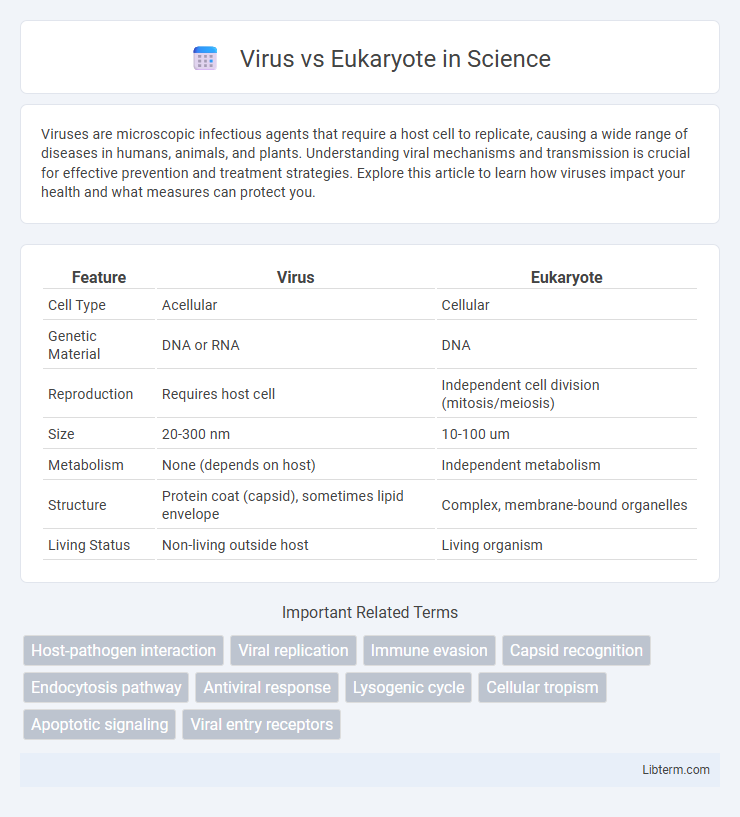Viruses are microscopic infectious agents that require a host cell to replicate, causing a wide range of diseases in humans, animals, and plants. Understanding viral mechanisms and transmission is crucial for effective prevention and treatment strategies. Explore this article to learn how viruses impact your health and what measures can protect you.
Table of Comparison
| Feature | Virus | Eukaryote |
|---|---|---|
| Cell Type | Acellular | Cellular |
| Genetic Material | DNA or RNA | DNA |
| Reproduction | Requires host cell | Independent cell division (mitosis/meiosis) |
| Size | 20-300 nm | 10-100 um |
| Metabolism | None (depends on host) | Independent metabolism |
| Structure | Protein coat (capsid), sometimes lipid envelope | Complex, membrane-bound organelles |
| Living Status | Non-living outside host | Living organism |
Introduction to Viruses and Eukaryotes
Viruses are microscopic infectious agents composed of genetic material encased in a protein coat, lacking cellular structure and metabolism, thus requiring a host cell for replication. Eukaryotes are complex organisms with membrane-bound organelles, including a nucleus containing linear DNA, enabling independent metabolic functions and reproduction. The fundamental distinction lies in viruses being acellular obligate parasites, whereas eukaryotes are cellular organisms capable of autonomous life processes.
Defining Characteristics: Virus vs Eukaryote
Viruses are acellular entities composed of genetic material, either DNA or RNA, enclosed in a protein coat, lacking cellular structures and metabolic processes, and depend entirely on host cells for replication. Eukaryotes are complex, multicellular or unicellular organisms characterized by membrane-bound organelles, including a nucleus containing linear DNA, and possess independent metabolic machinery for growth and reproduction. The key distinction lies in viruses being obligate intracellular parasites without cellular machinery, while eukaryotes function as autonomous living cells with organized internal structures.
Structural Differences: Cellular vs Acellular
Viruses are acellular entities lacking cellular structures such as a nucleus, cytoplasm, and membrane-bound organelles, instead comprising nucleic acid enclosed in a protein coat called a capsid. Eukaryotes possess complex cellular organization with defined nuclei, mitochondria, endoplasmic reticulum, and other membrane-bound organelles enabling metabolic processes and reproduction. The structural difference between viruses and eukaryotes is fundamental, with viruses relying on host cells for replication, while eukaryotes can independently carry out necessary life functions within their cellular framework.
Genetic Material: DNA and RNA Variations
Viruses exhibit diverse genetic material, containing either DNA or RNA, which can be single-stranded or double-stranded, enabling rapid mutation and adaptability. Eukaryotes, in contrast, universally possess double-stranded DNA organized into linear chromosomes within a nucleus, ensuring stable genetic inheritance. This fundamental difference in genetic material influences replication mechanisms, mutation rates, and evolutionary complexity between viruses and eukaryotic organisms.
Modes of Reproduction: Viral Replication vs Eukaryotic Cell Division
Viruses replicate through a process called viral replication, which involves hijacking a host cell's machinery to produce viral components that assemble into new virus particles. Eukaryotic cells reproduce by mitosis or meiosis, ensuring genetic material is accurately duplicated and distributed to daughter cells. Unlike viruses, eukaryotic cell division supports growth and tissue maintenance, while viral replication is solely focused on creating infectious progeny.
Metabolic Capabilities: Dependency and Independence
Viruses lack metabolic capabilities and depend entirely on host eukaryotic cells for energy production and biosynthesis, as they do not possess organelles or enzymes required for metabolism. Eukaryotes exhibit metabolic independence through mitochondria and chloroplasts, enabling ATP generation and biochemical pathways essential for cellular function. This fundamental difference highlights viral reliance on host machinery, contrasting with eukaryotic cellular autonomy in metabolism.
Evolutionary Origins and Relationships
Viruses lack cellular structures and metabolic processes, distinguishing them evolutionarily from eukaryotes, which possess complex organelles and linear DNA. Phylogenetic analyses suggest viruses may have originated from mobile genetic elements or ancient cellular ancestors, indicating a possible co-evolution with early eukaryotic cells. Studying viral genomes and eukaryotic hosts reveals horizontal gene transfer events that have influenced the evolutionary trajectory of both entities.
Interactions: Viruses Infecting Eukaryotic Hosts
Viruses infecting eukaryotic hosts utilize specialized mechanisms like receptor-mediated endocytosis and membrane fusion to enter cells, exploiting host machinery for replication. These interactions often trigger complex immune responses, including the activation of interferons and adaptive immunity to combat viral proliferation. Viral infection can lead to significant cellular changes, including apoptosis, immune evasion, and sometimes integration of viral DNA into the host genome, impacting eukaryotic cell function and health.
Immune Responses Against Viruses in Eukaryotes
Eukaryotic immune responses against viruses involve both innate and adaptive mechanisms, including pattern recognition receptors (PRRs) that detect viral components and trigger antiviral signaling pathways such as interferon production. Natural killer (NK) cells and cytotoxic T lymphocytes (CTLs) play crucial roles in eliminating virus-infected cells by recognizing viral antigens presented on major histocompatibility complex (MHC) molecules. Additionally, RNA interference (RNAi) pathways provide sequence-specific degradation of viral RNA, contributing to the eukaryotic antiviral defense system.
Medical and Biotechnological Implications
Viruses, as obligate intracellular parasites, hijack eukaryotic cellular machinery to replicate, making them central targets in antiviral drug development and gene therapy technologies. Understanding virus-eukaryote interactions drives advancements in vaccine design, particularly using viral vectors to deliver therapeutic genes in cancer and genetic disorder treatments. The manipulation of viral components has revolutionized biotechnology, enabling CRISPR-based genome editing and viral vector production for regenerative medicine applications.
Virus Infographic

 libterm.com
libterm.com